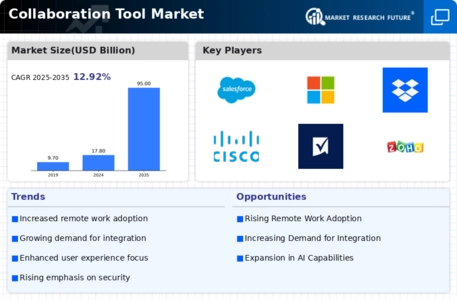Growing Emphasis on Data Security
In the Collaboration Tool Market, the growing emphasis on data security is a critical driver of market dynamics. As organizations increasingly rely on digital collaboration tools, concerns regarding data breaches and privacy violations have escalated. Companies are prioritizing solutions that offer robust security features, including end-to-end encryption, secure access controls, and compliance with data protection regulations. Recent studies indicate that nearly 70 percent of organizations consider data security a top priority when selecting collaboration tools. This heightened focus on security is prompting vendors to enhance their offerings, ensuring that users can collaborate without compromising sensitive information. As a result, the Collaboration Tool Market is likely to see a shift towards tools that not only facilitate collaboration but also provide comprehensive security measures to protect organizational data.
Integration of Advanced Technologies
The Collaboration Tool Market is significantly influenced by the integration of advanced technologies such as artificial intelligence and machine learning. These technologies enhance the functionality of collaboration tools, enabling features like automated scheduling, intelligent task management, and predictive analytics. The incorporation of AI-driven insights allows teams to optimize their workflows and make data-driven decisions. As organizations seek to improve efficiency and streamline operations, the demand for collaboration tools that leverage these technologies is expected to rise. Market analysis indicates that tools equipped with AI capabilities are likely to capture a larger share of the market, as they provide users with enhanced experiences and improved outcomes. This trend suggests that the Collaboration Tool Market will continue to evolve, with technology playing a pivotal role in shaping its future.
Expansion of Collaborative Workspaces
The Collaboration Tool Market is significantly impacted by the expansion of collaborative workspaces, which foster teamwork and innovation. As organizations increasingly adopt open office layouts and co-working spaces, the need for tools that facilitate collaboration in these environments becomes paramount. Research indicates that companies utilizing collaborative workspaces experience a 20 percent increase in productivity. This trend is driving the demand for collaboration tools that support both in-person and remote interactions, ensuring that teams can communicate effectively regardless of their physical location. The rise of collaborative workspaces is likely to influence the design and functionality of collaboration tools, prompting vendors to develop solutions that enhance the collaborative experience. As a result, the Collaboration Tool Market is poised for growth, as organizations seek to leverage these tools to maximize the benefits of collaborative work environments.
Rise of Mobile Collaboration Solutions
The Collaboration Tool Market is witnessing a significant rise in mobile collaboration solutions, driven by the increasing use of smartphones and tablets in professional settings. As employees seek flexibility and convenience, organizations are adopting mobile-friendly collaboration tools that enable access to projects and communication on-the-go. Recent statistics reveal that mobile collaboration tools are expected to account for over 30 percent of the overall collaboration tool market by 2026. This trend indicates a shift towards solutions that prioritize user experience and accessibility, allowing teams to remain productive regardless of their location. The demand for mobile collaboration tools is likely to continue growing, as organizations recognize the importance of enabling their workforce to collaborate effectively in a fast-paced, mobile-centric environment. Consequently, the Collaboration Tool Market is adapting to meet these evolving needs.
Increased Demand for Remote Collaboration
The Collaboration Tool Market experiences a notable surge in demand for remote collaboration solutions. As organizations increasingly adopt flexible work arrangements, the need for tools that facilitate seamless communication and project management rises. According to recent data, the market for collaboration tools is projected to grow at a compound annual growth rate of approximately 12 percent over the next five years. This growth is driven by the necessity for teams to collaborate effectively, regardless of their physical location. Companies are investing in platforms that offer real-time collaboration features, file sharing, and integrated communication channels. The emphasis on remote work has led to a diversification of tools available in the market, catering to various industries and team sizes. Consequently, the Collaboration Tool Market is likely to witness a continuous influx of innovative solutions designed to enhance productivity and connectivity.

























